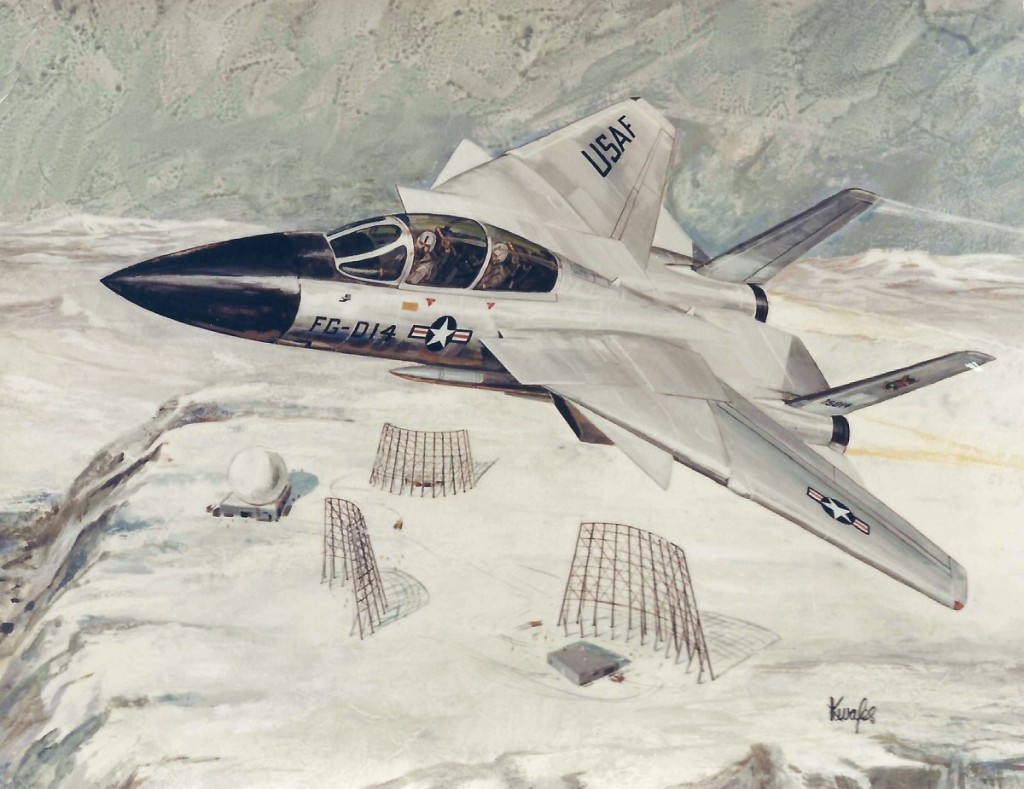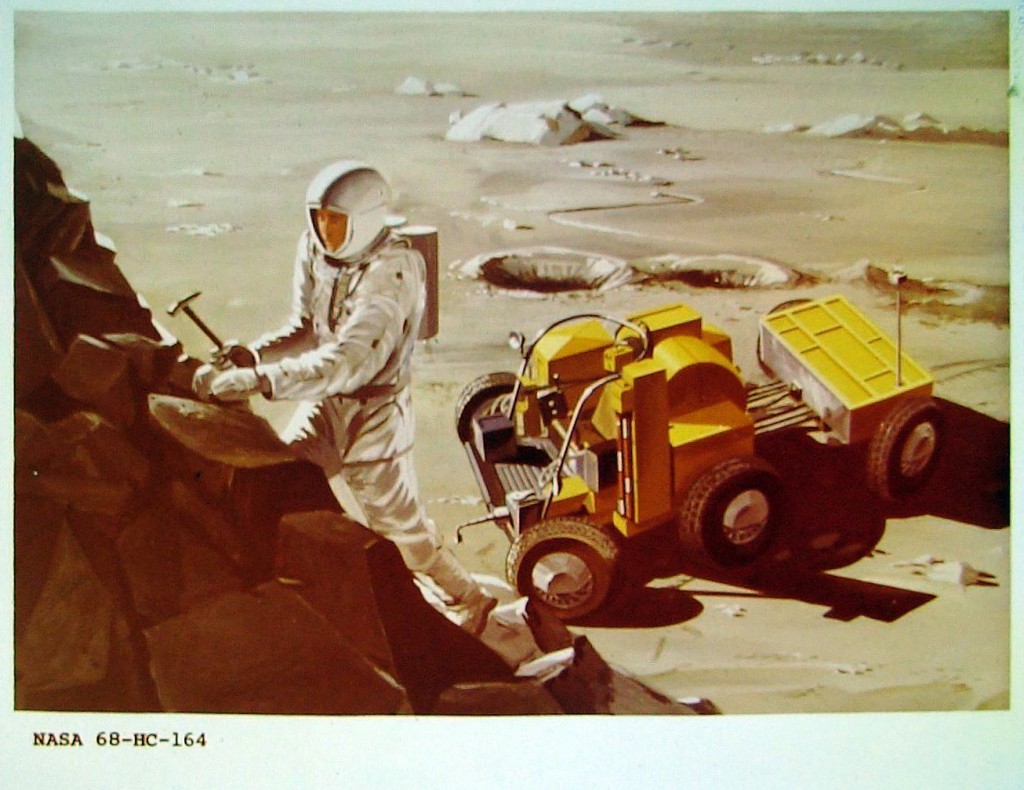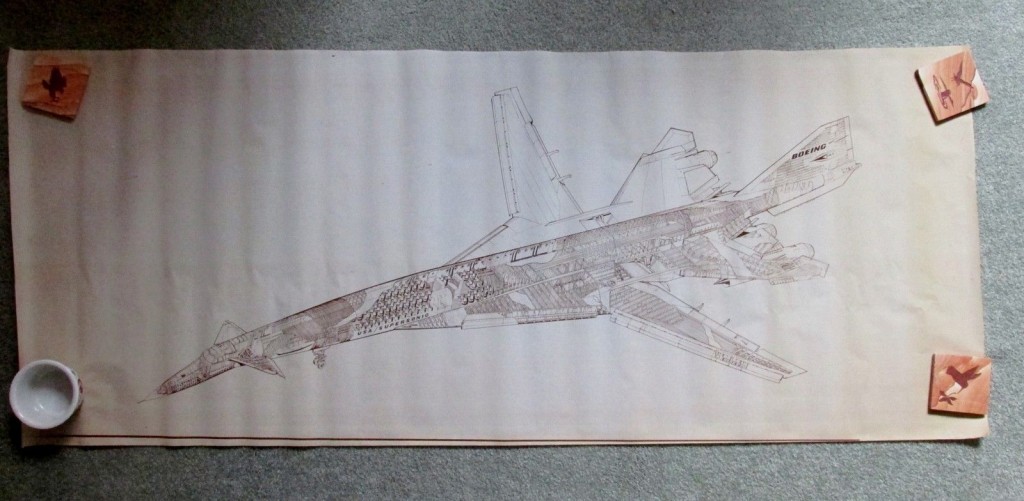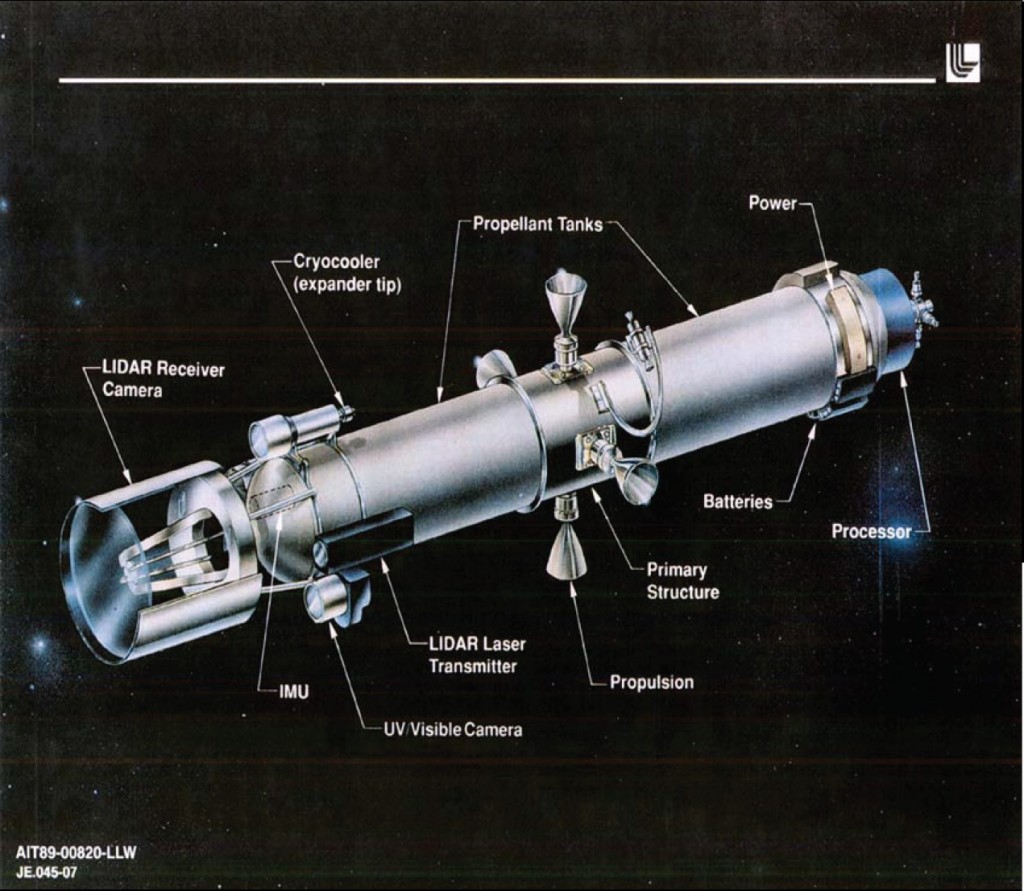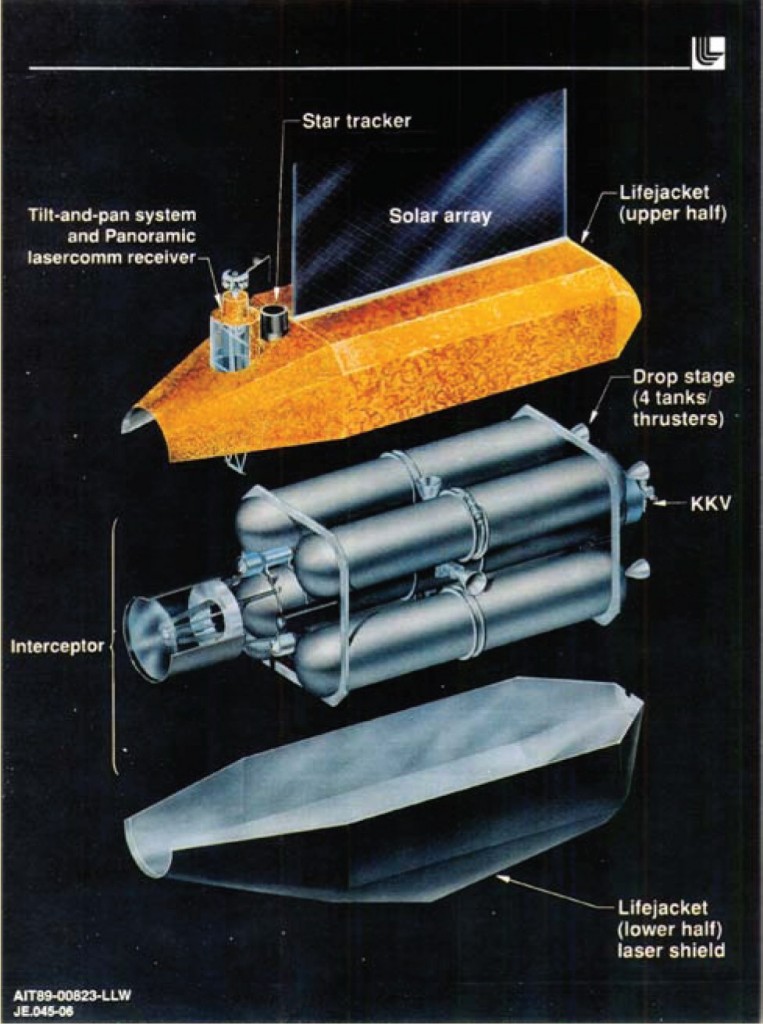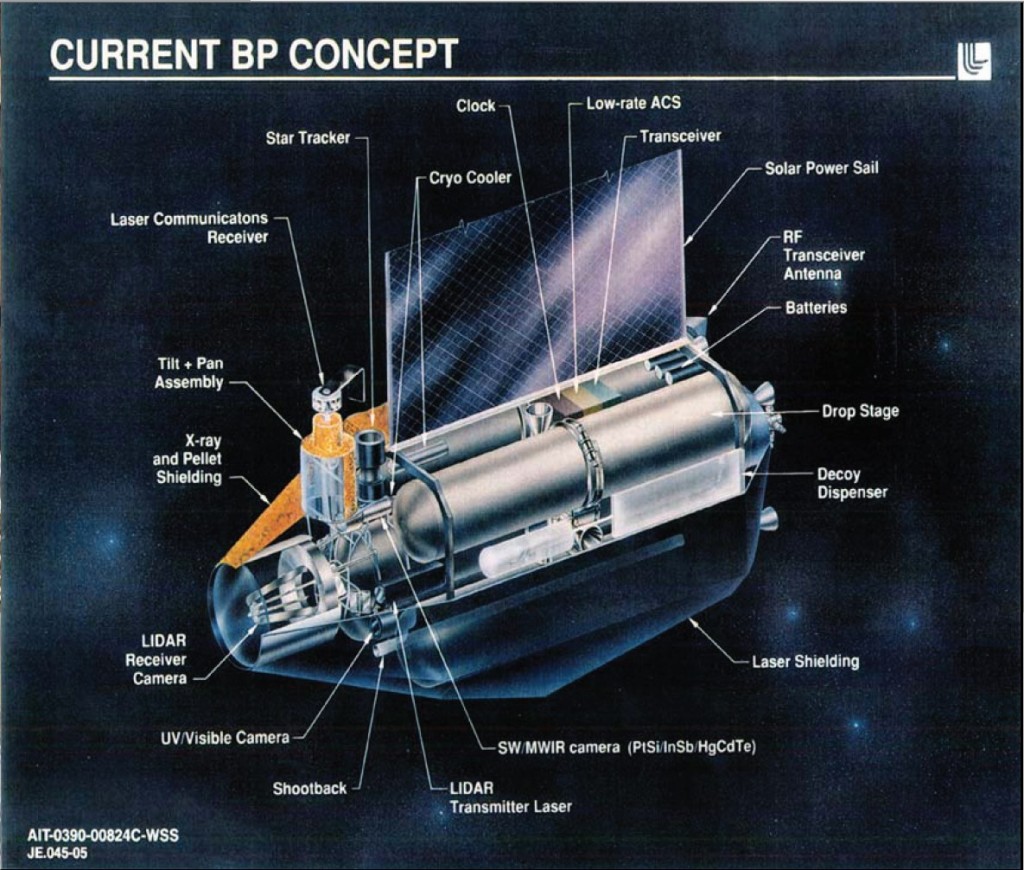A piece of artwork, presumably from Grumman (it came from a photo album full of Grumman artwork), depicting an F-14 in USAF colors. Shown flying over ballistic missile warning radar facilities Way Up North. It appears to be a pretty stock F-14… seems equipped with an M-61 and an AIM-54.
Post-war US Army film showing US soldiers poking around with some captured German rocket vehicles: the Bachem Ba-349 (basically a manned surface-to-air missile) and the Ruhrstahl X-4, an air-to-air missile. The X-4 would have been difficult to use… wire guided like the modern TOW missile, the lone fighter pilot launching the missile would have to fly his plane while simultaneously steering the missile, using a Mark I Eyeball to track a visible flare.
[youtube t-P8NjcMemY]
A film about NERVA (Nuclear Energy for Rocket Vehicle Applications), 1968.
[youtube WoiVej1rccs]
Provides a basic description of nuclear rockets, plus some art, animation and diagrams of nuclear propelled space vehicles along with footage of test firings.
For those of you following along with my email-listing updates regarding the Boeing 2707 eBay listing and how to get in on it… it has now closed. The package of proposal books, art & diagram showed up today, and now the process of scanning begins.
For those of y’all reading this going “WTF?” and wondering why you don’t know what I’m yapping about and why you’re not on the list to receive a gigabyte or so of SST stuff… probably has something to do with you not being on the emailing list.
LLNL artwork depicting the hit-to-kill terminal stage of the Brilliant Pebbles, sans the booster drop-stages. It does not seem to have a go-forward thruster; that would seem to have been provided by the boosters. What it does have is a fair amount of divert capability provided by the thrusters mounted at what should be the center of gravity.
While dimensions are unknown with any certainty, this would be a fairly small system. The kill vehicle – which in this case is somewhat difficult to distinguish from the propulsion system – had a mass goal of only 2.5 kilograms (according to THIS), while the booster was to mass about 100 kilograms. THIS source said the vehicles were about one meter long.
Lawrence Livermore National Lab artwork of the Brilliant Pebbles anti-missile satellite within its protective “cocoon.” Compare to artwork HERE. Dimensions remain elusive.
Until December 18, the AIAA is selling 25 books for $25, and ten books for $10. Some good stuff here at some pretty substantial discount. You don’t have to be an AIAA member to get the discount.
NOTE: I have no relationship with the AIAA, and don’t make a nickel off these sales. So.. if you want to buy stuff and still feel like you are Supporting The Cause, feel free to navigate to Amazon.com through the “Search’ box that’s to the upper right of this page. i get a tiny fraction of the sales prices for items purchased via search & referral. I suggest buying stuff like laptops and computers and cars and such. So long as I’m getting a small percentage, it might as well be a small percentage of a large dollar value…
The Aircraft Designers: A Grumman Historical Perspective
Michael V. Ciminera
$39.95
NOW $25!
Meeting the Challenge: The Hexagon KH-9 Reconnaissance Satellite
Phil Pressel
$39.95
NOW $25!
Space Shuttle Legacy: How We Did It and What We Learned
Roger D. Launius; John Krige; James I. Craig
$49.95
NOW $25!
Augustine’s Laws
Norman R. Augustine
$39.95
NOW $25!
100 years of Flight
Frank H. Winter and F. Robert van der Linden
$69.95
NOW $25!
Have Blue and the F-117A: Evolution of the “Stealth Fighter”
David C. Aronstein and Albert C. Piccirillo
$59.95
NOW $25!
Advanced Tactical Fighter to F-22 Raptor: Origins of the 21st Century Air Dominance Fighter
David C. Aronstein, Michael J. Hirschberg, and Albert C. Piccirillo
$49.95
NOW $25!
Aerodynamic Principles of Flight Vehicles
Argyris Panaras
$49.95
NOW $25!
Voyager Tales: Personal Views of the Grand Tour
David W. Swift
$74.95
NOW $25!
Hans Von Ohain
Margaret Conner
$54.95
NOW $25!
Road to Mach 10: Lessons Learned from the X-43A Flight Research Program
Curtis Peebles
$39.95
NOW $25!
Eleven Seconds into the Unknown
Curtis Peebles
$39.95
NOW $25!
Blazing the Trail: The Early History of Spacecraft and Rocketry
Mike Gruntman
$39.95
NOW $25!
The Rocket Company
Patrick Stiennon and David Hoerr
$34.95
NOW $25!
Rocketdyne: Powering Humans into Space
Vince Wheelcock
$39.95
NOW $25!
Space Exploration and Astronaut Safety
Joseph N. Pelton
$49.95
NOW $25!
Shades of Gray
L. Parker Temple III
$49.95
NOW $25!
Unmanned Aviation: A Brief History of Unmanned Aerial Vehicles
Laurence R. Newcome
$44.95
NOW $25!
Starting Something Big: The Commercial Emergence of GE Aircraft Engines
Robert V. Garvin
$39.95
NOW $25!
The Power to Fly: An Engineer’s Life
Martin Ducheny and Brian Rowe
$39.95
NOW $25!
Aerospace Engineering Education During the First Century of Flight
Barnes McCormick; Eric Jumper; Conrad Newberry
$89.95
NOW $25!
The History of North American Small Gas Turbine Aircraft Engines
Richard Leyes II; William Fleming
$49.95
NOW $25!
Methods to Extend Mechanical Component Life: Lessons Learned with Space Vehicle and Rocket Engine Components
Dieter Huzel
$44.95
NOW $25!
The Engines of Pratt & Whitney: A Technical History
Jack Connors
$49.95
NOW $25!
From Rainbow to Gusto
Paul A. Suhler
$39.95
NOW $25!
Experiments in Aerodynamics
S. Langley
$29.95
NOW $10!
Skycrane: Igor Sikorsky’s Last Vision
John A. McKenna
$39.95
NOW $10!
Hired Minds
Bryan Gardner
$19.95
NOW $10!
Terminal Chaos: Why U.S. Air Travel Is Broken and How to Fix It
George L. Donohue; Russell D. Shaver II
$29.95
NOW $10!
Space: The Fragile Frontier
Mark Williamson
$39.95
NOW $10!
Rocketeers and Gentlemen Engineers
Tom Crouch; Buzz Aldrin
$39.95
NOW $10!
The Superpower Odyssey: A Russian Perspective on Space Cooperation
Yuri Karash
$49.95
NOW $10!
Centennial of Powered Flight
Gerard Faeth
$24.95
NOW $10!
When the Airlines Went to War
Robert Serling
$24.95
NOW $10!
Advice to Rocket Scientists
Jim Longuski
$19.95
NOW $10!
Take this for what it’s worth:
PLA dreams of turning moon into Death Star, says expert
An expert from the China National Space Administration’s Lunar Exploration Programme Center… added that the moon is the Earth’s only natural satellite, and it can be transformed into a deadly weapon. Like the Death Star in Star Wars, the moon could hypothetically be used as a military battle station and ballistic missiles could be launched against any military target on Earth.
Various weapons testing sites could also be established on the moon, the source said.
Welcome to Project Horizon V 2.0.
For those unaware, Project Horizon was a 1959 US Army study of a moon base for military purposes. Included in that was the use of the moon as a missile base. The idea is not *entirely* ludicrous: a missile base on the moon would be several days away from a strike launched from Earth. So if Nation A launched a first strike on Nation B and Nation B has a lunar base, then Nation A can expect a rain of ruin from the moon a little later. However, the US decided that Polaris missile subs were cheaper.
